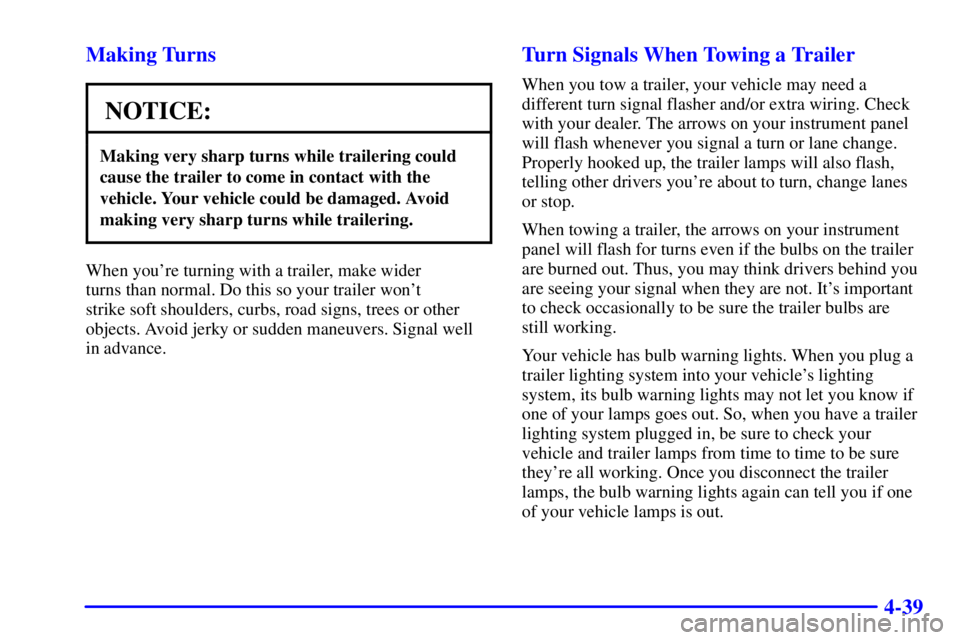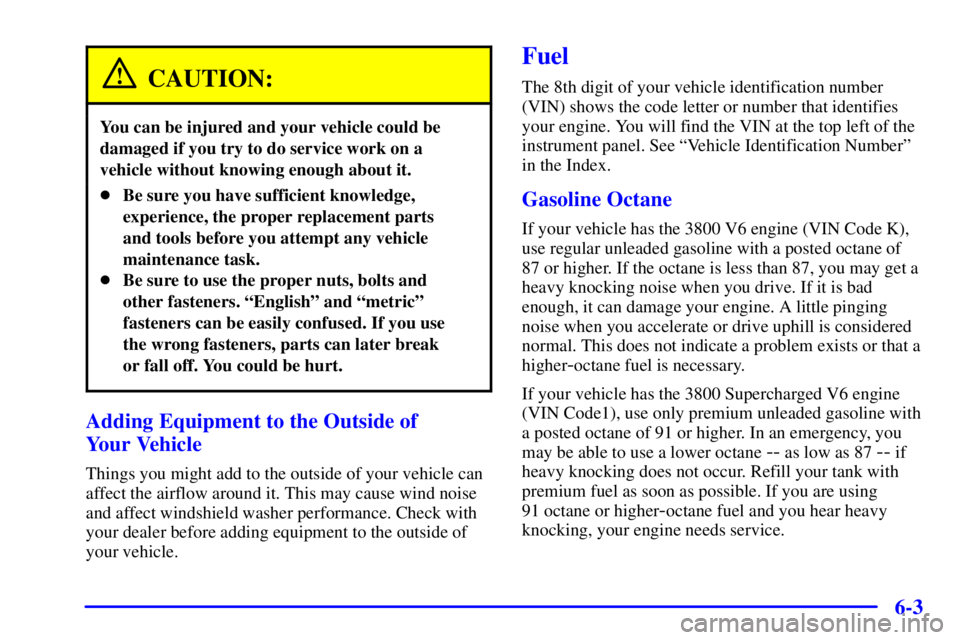Page 160 of 395
2-97
Head-Up Display (HUD)
(If Equipped)
CAUTION:
If the HUD image is too bright, or too high in
your field of view, it may take you more time to
see things you need to see when it's dark outside.
Be sure to keep the HUD image dim and placed
low in your field of view.
If your vehicle is equipped with the Head-Up Display
(HUD), you can see some of the driver information that
appears on your instrument panel cluster.
The information may be displayed in English or metric
units and appears as a reflection in the windshield. The
HUD consists of the following information:
�Speedometer Reading
�Turn Signal Indicators
�High
-Beam Headlamp Indicator
�CHECK GAGES Message
The HUD shows these images when they are lighted on
the instrument panel cluster.
Be sure to continue scanning your displays, controls and
driving environment just as you would in a vehicle
without HUD. If you never look at your instrument
panel, you may not see something important, such
as a warning light.
Page 167 of 395

3-4
AUTO (Automatic Climate Control): Press the AUTO
button when you want the system to automatically
maintain a set temperature. When the system is set for
automatic operation, air will come from the floor ducts,
instrument panel outlets or windshield outlets depending
on the temperature inside the vehicle, the outside
temperature and the sun load. Sun and temperature
sensors automatically adjust the air temperature, the
airflow direction and the fan speed to maintain your
comfort setting. The system may supply cooler air to the
side of the vehicle toward the sun. Be careful not to put
anything over the sensors on top of the dash.
To find your preferred temperature setting, start with the
system in AUTO mode and the temperature set at 75�F
(24�C). Give the vehicle about 20 minutes to stabilize,
and adjust your the temperature setting, if necessary,
using the TEMP button. The display will show the
selected temperature, fan speed and airflow direction for
a few seconds, and then it will display the outside
temperature. If you choose a temperature setting of 60�F
(15�C), the system will remain at the maximum cooling
setting and fan speed. If you choose a temperature
setting of 90�F (33�C), the system will remain at the
maximum heat setting and fan speed. Choosing either
maximum setting will not cause the system to heat or
cool any faster.In cold weather, the system will delay turning the fan
on high, to avoid blowing cold air into the vehicle. The
length of the delay depends on the engine coolant
temperature and the outside temperature. Pressing the
FAN, AIR FLOW or FRONT buttons will override
this delay, turn off the AUTO setting and change the
fan speed.
Air Conditioning
On hot days, open the windows long enough to let hot
inside air escape. This reduces the time it takes for your
vehicle to cool down. Then keep your windows closed
for the air conditioner to work its best.
On very hot days, the automatic system will enter the
recirculation mode and the temperature door will be
positioned at the full cold position for maximum cooling
for as long as necessary to reach the set temperature.
You can choose the extreme temperature setting of
60�F (15�C), but the system will not cool any faster.
Page 169 of 395

3-6
NOTICE:
Don't use a razor blade or something else sharp
on the inside of the rear window. If you do, you
could cut or damage the warming grid or the
integrated rear window antenna, and the repairs
wouldn't be covered by your warranty.
Passenger Climate Control
The front seat passenger can control the air temperature
in his or her seating area. This can be set up to 5�F
(3�C) cooler or warmer than the primary setting. You
can activate this feature by sliding the lever located on
the right side of the instrument panel toward WARM
or COOL.
If the passenger climate control has been turned on, it
can be turned off by pressing the OFF button on the
climate control system faceplate once. Pressing the OFF
button a second time will turn off the main system.
Personal Choice Comfort Controls
(If Equipped)
This feature enables up to two drivers to store and recall
comfort control settings for the temperature, fan speed
and the direction of the air flow.
The memory buttons (1 or 2) for this feature are located
on the driver's door panel and correspond to the
numbers (1 or 2) found on the back of each remote
keyless entry transmitter.
To recall comfort settings, press the unlock button on the
remote keyless entry transmitter and put the ignition in
ACCESSORY or RUN. The climate control setting last
chosen by the identified driver (1 or 2) will be recalled.
Page 231 of 395

4-39 Making Turns
NOTICE:
Making very sharp turns while trailering could
cause the trailer to come in contact with the
vehicle. Your vehicle could be damaged. Avoid
making very sharp turns while trailering.
When you're turning with a trailer, make wider
turns than normal. Do this so your trailer won't
strike soft shoulders, curbs, road signs, trees or other
objects. Avoid jerky or sudden maneuvers. Signal well
in advance.
Turn Signals When Towing a Trailer
When you tow a trailer, your vehicle may need a
different turn signal flasher and/or extra wiring. Check
with your dealer. The arrows on your instrument panel
will flash whenever you signal a turn or lane change.
Properly hooked up, the trailer lamps will also flash,
telling other drivers you're about to turn, change lanes
or stop.
When towing a trailer, the arrows on your instrument
panel will flash for turns even if the bulbs on the trailer
are burned out. Thus, you may think drivers behind you
are seeing your signal when they are not. It's important
to check occasionally to be sure the trailer bulbs are
still working.
Your vehicle has bulb warning lights. When you plug a
trailer lighting system into your vehicle's lighting
system, its bulb warning lights may not let you know if
one of your lamps goes out. So, when you have a trailer
lighting system plugged in, be sure to check your
vehicle and trailer lamps from time to time to be sure
they're all working. Once you disconnect the trailer
lamps, the bulb warning lights again can tell you if one
of your vehicle lamps is out.
Page 242 of 395
5-9
Engine Overheating
You will find a warning light about a hot engine, as well
as a coolant temperature gage, on your instrument panel.
If Steam Is Coming From Your Engine
CAUTION:
Steam from an overheated engine can burn you
badly, even if you just open the hood. Stay away
from the engine if you see or hear steam coming
from it. Just turn it off and get everyone away
from the vehicle until it cools down. Wait until
there is no sign of steam or coolant before you
open the hood.
If you keep driving when your engine is
overheated, the liquids in it can catch fire.
You or others could be badly burned. Stop your
engine if it overheats, and get out of the vehicle
until the engine is cool.
NOTICE:
If your engine catches fire because you keep
driving with no coolant, your vehicle can be
badly damaged. The costly repairs would not
be covered by your warranty.
Page 267 of 395

6-3
CAUTION:
You can be injured and your vehicle could be
damaged if you try to do service work on a
vehicle without knowing enough about it.
�Be sure you have sufficient knowledge,
experience, the proper replacement parts
and tools before you attempt any vehicle
maintenance task.
�Be sure to use the proper nuts, bolts and
other fasteners. ªEnglishº and ªmetricº
fasteners can be easily confused. If you use
the wrong fasteners, parts can later break
or fall off. You could be hurt.
Adding Equipment to the Outside of
Your Vehicle
Things you might add to the outside of your vehicle can
affect the airflow around it. This may cause wind noise
and affect windshield washer performance. Check with
your dealer before adding equipment to the outside of
your vehicle.
Fuel
The 8th digit of your vehicle identification number
(VIN) shows the code letter or number that identifies
your engine. You will find the VIN at the top left of the
instrument panel. See ªVehicle Identification Numberº
in the Index.
Gasoline Octane
If your vehicle has the 3800 V6 engine (VIN Code K),
use regular unleaded gasoline with a posted octane of
87 or higher. If the octane is less than 87, you may get a
heavy knocking noise when you drive. If it is bad
enough, it can damage your engine. A little pinging
noise when you accelerate or drive uphill is considered
normal. This does not indicate a problem exists or that a
higher
-octane fuel is necessary.
If your vehicle has the 3800 Supercharged V6 engine
(VIN Code1), use only premium unleaded gasoline with
a posted octane of 91 or higher. In an emergency, you
may be able to use a lower octane
-- as low as 87 -- if
heavy knocking does not occur. Refill your tank with
premium fuel as soon as possible. If you are using
91 octane or higher
-octane fuel and you hear heavy
knocking, your engine needs service.
Page 273 of 395
6-9
Checking Things Under the Hood
CAUTION:
An electric fan under the hood can start up and
injure you even when the engine is not running.
Keep hands, clothing and tools away from any
underhood electric fan.
CAUTION:
Things that burn can get on hot engine parts and
start a fire. These include liquids like gasoline,
oil, coolant, brake fluid, windshield washer and
other fluids, and plastic or rubber. You or others
could be burned. Be careful not to drop or spill
things that will burn onto a hot engine.
Hood Release
To open the hood, do the following:
1. Pull the handle inside
the vehicle. It is located
on the lower left side of
the instrument panel.
Page 324 of 395
6-60 Cleaning the Top of the Instrument Panel
Use only mild soap and water to clean the top surfaces
of the instrument panel. Sprays containing silicones or
waxes may cause annoying reflections in the windshield
and even make it difficult to see through the windshield
under certain conditions.
Cleaning Interior Plastic Components
Use only a mild soap and water solution on a soft
cloth or sponge. Commercial cleaners may affect the
surface finish.
Cleaning Speaker Covers
Vacuum around a speaker cover gently, so that the
speaker won't be damaged. Clean spots with just water
and mild soap.
Care of Safety Belts
Keep belts clean and dry.
CAUTION:
Do not bleach or dye safety belts. If you do, it
may severely weaken them. In a crash, they
might not be able to provide adequate protection.
Clean safety belts only with mild soap and
lukewarm water.